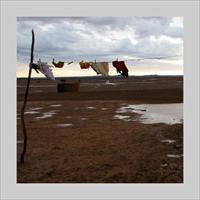MALI: When the world’s deserts flood

In August, floods loosened the dry caked Sahelian earth in Gao, northern Mali, affecting more than 1,000 people, many of whom temporarily took refuge in area schools. While displaced families have since vacated schools in time for the beginning of the school year on 6 October, many families remain homeless, according to the Mali Red Cross.
“Things have mostly returned to normal,” said Mali Red Cross Executive Secretary Sibiry Diarra, “People are staying with their families as their destroyed homes are being reconstructed.”
The Red Cross estimates flooding destroyed some 100 homes located near the 4000-kilometre Niger River, which cuts through northeastern Mali.
Semi-arid regions across Africa are seeing increased flooding in recent years. One expert says more study is needed into the role of global climate change in the heavy Sahel rains.
Immediately following the Gao storms, the most severely affected families – some 100 – each received 50kgs of rice, cooking oil, blankets, mosquito nets, straw mats, a water jug, cooking supplies, soap, a tea kettle, a plastic tarpaulin and a 15-litre bucket from the Malian Red Cross, Diarra told IRIN.
Omar Baddour, head of the world climate and data monitoring division at the Geneva-based World Meteorological Organization, told IRIN even deserts are vulnerable to destructive flash floods: “They are as vulnerable as any other place to flooding. The origin of a storm is not the desert, but the surrounding lakes and seas. If the environmental conditions are right to release clouds’ moisture, there will be storms.”
The meteorologist explained that last year’s Sahel floods were linked to the climate phenomenon known as La Nina, in which ever-colder Pacific Ocean temperatures lead to flooding.
As West Africa’s rainy season comes to an end, thousands of families have been affected by flooding in Liberia, Guinea, Guinea-Bissau, Burkina Faso, Niger, Gambia, Senegal, Benin, Togo, Mali and Ghana, according to disaster relief organisations.
To date, affected countries in central Africa, which experiences a slightly later rainy season, include Cameroon, Chad and Central African Republic.
Meteorologist Baddour said more research is needed to understand why semi-arid regions are getting more flooding in recent years: “Global assessments have shown how climate change can lead to more intense flooding. But for the Sahel, we do not have enough data. The desert is so sparsely populated that it is hard to justify setting up observatories there. But we do know that if there is enough environmental pressure, even the desert can drown.”
 Back and Next - Back and Next
Back and Next - Back and Next See Also - See Also
See Also - See Also